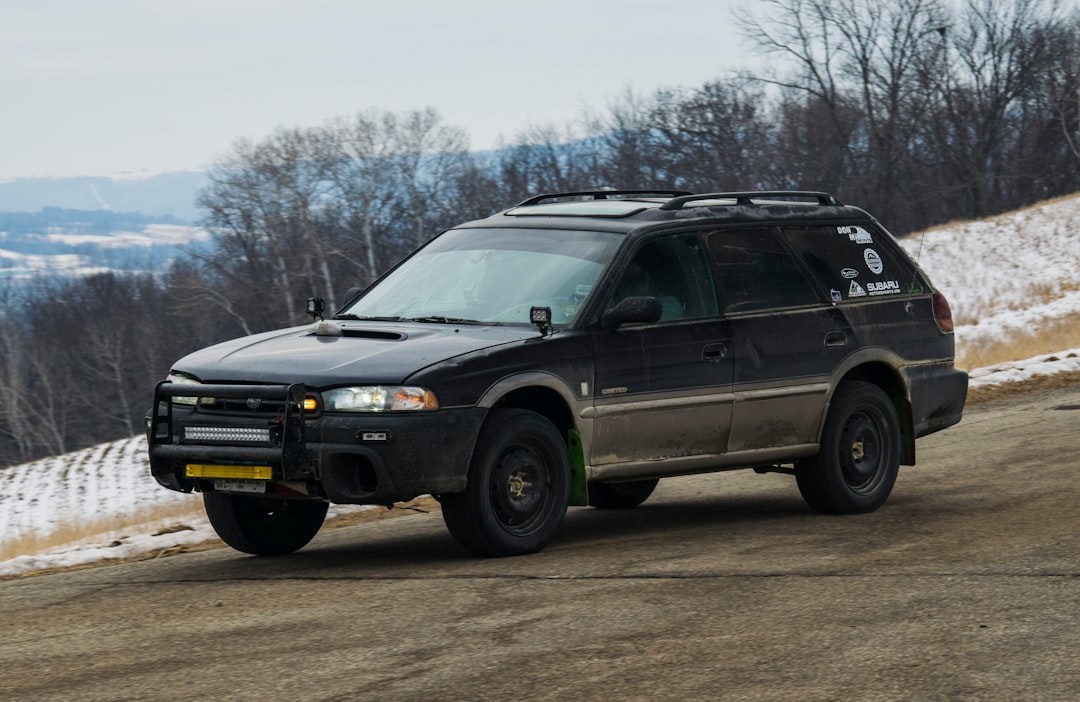Subaru Outback: 10 Powerful Reasons to Love It in 2025
The Subaru Outback: Trip-Ready Wagon Meets SUV Capability
The Subaru Outback is a midsize crossover that blends station wagon practicality with SUV capability, featuring standard all-wheel drive, up to 9.5 inches of ground clearance, and a choice between a standard 182-hp 2.5L engine or a turbocharged 260-hp 2.4L engine.
Key Highlights of the 2024-2025 Subaru Outback:
- Starting Price: $28,895-$44,330 MSRP
- Fuel Economy: Up to 26 mpg city/33 mpg highway
- Safety Rating: 5-Star Overall from NHTSA
- Standard Features: Symmetrical AWD, EyeSight Driver Assist Technology
- Cargo Space: 32.6 cu ft (seats up), 75.7 cu ft (seats folded)
- Towing Capacity: Up to 3,500 pounds with turbocharged engine
The Subaru Outback has built a loyal following for good reason. As the “mid-weight trail-hiker boot of automobiles,” it tackles off-road trips while maintaining car-like comfort and fuel efficiency. What began in 1995 as a lifted Legacy wagon has evolved into a versatile vehicle that created its own category.
What makes the Outback special is its remarkable staying power. An impressive 97% of Outback vehicles sold in the last 10 years are still on the road today—outperforming competitors like the Honda CR-V, Toyota RAV4, and Hyundai Santa Fe.
The Outback’s practical design offers a lower roof height than typical SUVs, making loading gear onto roof rails easier, while its standard all-wheel drive tackles snow, mud, and unpaved roads with confidence. Inside, you’ll find a spacious cabin with modern tech including an 11.6-inch touchscreen with wireless Apple CarPlay and Android Auto.
Whether you’re looking for a daily commuter that can handle weekend trips or a capable off-roader that doesn’t sacrifice comfort, the Outback delivers a compelling balance of versatility, safety, and value.

Quick look at subaru outback:
Why the 2025 Subaru Outback Stands Out
The Subaru Outback has undergone an impressive change for 2025, sporting a completely refreshed exterior and interior that pushes this beloved vehicle further into crossover territory while honoring its wagon heritage. The redesign gives it a more confident stance with a boxier silhouette, stacked headlight clusters, and a bold, eye-catching grille that turns heads on and off the trail.
What really makes the Subaru Outback special in today’s crowded market? For starters, it comes standard with Symmetrical All-Wheel Drive—a feature most competitors treat as a premium add-on that can cost thousands extra. This isn’t just any AWD system either. It constantly evaluates your driving conditions, analyzing acceleration, braking, and cornering in real-time to send power exactly where you need it most. When winter storms hit or you’re navigating a muddy campsite, you’ll immediately understand the difference.
Safety credentials? The 2025 Outback knocks it out of the park with a perfect 5-Star Overall Vehicle Score from the National Highway Traffic Safety Administration. It’s no surprise that Consumer Reports continues to recommend this model with enthusiasm. Every trim level comes equipped with Subaru’s renowned EyeSight Driver Assist Technology—because Subaru believes safety shouldn’t be an optional upgrade.
Key Highlights & Competitive Edge
When you park the Subaru Outback next to its rivals, several advantages become immediately apparent. Its ground clearance is simply best—up to a towering 9.5 inches in the Wilderness trim, allowing you to clear obstacles that would leave other crossovers stranded. The unique boxer engine layout places weight lower in the chassis, giving you noticeably better stability through corners and rough terrain.
| Feature | Subaru Outback | Toyota RAV4 | Honda CR-V | Ford Bronco Sport |
|---|---|---|---|---|
| Standard AWD | Yes | No | No | No |
| Ground Clearance | Up to 9.5 in | 8.4 in | 8.2 in | 8.8 in |
| Engine Layout | Boxer (lower center of gravity) | Inline | Inline | Inline |
| 10-Year Longevity Rate | 97% | Lower | Lower | N/A (newer model) |
| Cargo Space | 75.7 cu ft | 69.8 cu ft | 76.5 cu ft | 65.2 cu ft |
| Base MSRP (2025) | $30,430 | $29,825 | $29,500 | $30,810 |
Perhaps most impressive is that remarkable 97% longevity rate—meaning nearly all Outbacks sold in the last decade are still faithfully serving their owners. This isn’t just a vehicle; it’s a long-term relationship. The Outback’s lower roof height compared to traditional SUVs also makes a practical difference in everyday life, especially when loading bikes, kayaks, or cargo boxes onto the roof rails.
Pros and Cons Snapshot
The Subaru Outback certainly isn’t perfect (though its fans might argue otherwise). Let’s be real about its strengths and weaknesses.
On the plus side, you’ll love the exceptional cargo versatility with 75.7 cubic feet of space when you fold those seats down—enough room for camping gear for the whole family. The standard all-wheel drive with specialized X-Mode handles different terrain types with confidence, whether you’re dealing with snow, dirt, or mud. Safety features are comprehensive and actually work as advertised, not just marketing hype. Many owners report that the Outback’s ride quality rivals luxury vehicles costing thousands more. And when it comes time to sell, you’ll appreciate the strong resale value that Subarus are famous for.
The downsides? The base engine can feel a bit winded during highway passing maneuvers (the turbo solves this, but at a higher price point). The CVT transmission, while efficient, does produce that characteristic drone under heavy acceleration. Tech-savvy drivers might find the 11.6-inch touchscreen occasionally laggy and menu-heavy. If you opt for the rugged Wilderness model, expect more road noise from those aggressive off-road tires. And yes, the turbocharged models prefer premium fuel, which adds to ownership costs.
For adventurous souls looking for a vehicle that balances everyday practicality with genuine off-road capability, the Subaru Outback remains the benchmark that others aspire to match. It’s the Swiss Army knife of the automotive world—ready for whatever life throws your way.
Performance & Capability
The heart of any Subaru Outback is its distinctive BOXER® engine. Unlike conventional engines, Subaru’s horizontally opposed layout places the pistons 180 degrees apart, creating a naturally balanced design that reduces vibration and lowers the vehicle’s center of gravity for improved handling.

Engine Options & Specs
The 2025 Subaru Outback gives you two fantastic engine choices, each with its own personality.
The standard 2.5L naturally aspirated flat-four is the sensible friend in your life – reliable, efficient, and more capable than you might expect with 182 horsepower and 176 lb-ft of torque. It’ll get you from 0-60 mph in about 8.8 seconds – not breaking any speed records, but perfectly adequate for merging onto highways and everyday driving. With its direct injection system and dual overhead camshafts, this engine strikes a nice balance between power and efficiency.
If you’re looking for something with more pep in its step, the available 2.4L turbocharged flat-four (in XT models) is your ticket to more exciting drives. With 260 horsepower and a meaty 277 lb-ft of torque that kicks in at just 2,000 rpm, this engine transforms the Outback’s personality. You’ll feel it in the 0-60 time of around 5.8 seconds – quicker than many dedicated sports sedans! This powerplant comes standard on the Onyx Edition XT, Limited XT, Touring XT, and Wilderness trims.
Both engines pair with Subaru’s Lineartronic® CVT, which has been cleverly tuned to mimic the feel of a traditional automatic. Those paddle shifters on the steering wheel aren’t just for show – they give you access to eight simulated gears when you want more control. The SI-DRIVE system lets you toggle between Intelligent mode (for smooth, efficient cruising) and Sport mode (for more responsive throttle and transmission behavior) depending on your mood or driving conditions.
Fuel Economy & Real-World MPG
One of the Subaru Outback’s most impressive tricks is delivering solid fuel economy despite having standard all-wheel drive (which typically hurts efficiency in other vehicles).
The 2.5L engine is the efficiency champ, earning EPA estimates of 26 mpg city, 33 mpg highway, and 29 mpg combined. That’s territory usually reserved for front-wheel drive crossovers, making the Outback a smart choice for the efficiency-minded trip seeker.
The more powerful 2.4L turbo engine naturally trades some efficiency for performance, but still manages a respectable 23 mpg city, 30 mpg highway, and 26 mpg combined. The off-road focused Wilderness trim, with its taller ride height and all-terrain tires, comes in at 21/26/23 mpg.
In real-world testing, I’ve found the Outback with the base engine typically achieves around 28 mpg during highway-heavy driving – slightly below the EPA rating but still impressive for an AWD vehicle with this much capability. Many owners report regularly exceeding 30 mpg on long highway trips, particularly when using the adaptive cruise control.
For the most current fuel economy data, check out the latest mileage figures from the EPA.
Off-Road, Towing & All-Weather Grip
This is where the Subaru Outback truly earns its reputation as the Swiss Army knife of vehicles. Every single Outback comes standard with Subaru’s Symmetrical All-Wheel Drive system, which continuously monitors conditions and sends power where it’s needed most. It’s not an afterthought or a part-time system – it’s engineered from the ground up for all-weather performance.
The standard X-MODE feature is like having an off-road expert riding shotgun. It automatically optimizes the engine, transmission, AWD system, and brakes for slippery or uneven terrain. The included Hill Descent Control maintains a steady speed when navigating steep downhill sections, allowing you to focus on steering.
With 8.7 inches of ground clearance (more than many “proper” SUVs), the standard Outback already offers impressive capability. But the Wilderness trim takes things to another level with a lifted suspension providing 9.5 inches of clearance – enough to tackle serious trails without scraping your undercarriage. The Wilderness also gets an improved X-MODE with specific settings for deep snow and mud, all-terrain tires, protective skid plates, and improved approach/departure angles (20° and 23.6° respectively).
When it comes to hauling, the Subaru Outback doesn’t disappoint. The base 2.5L engine can tow up to 2,700 pounds – enough for a small trailer or a couple of jet skis. Opt for the turbocharged models and that capacity jumps to 3,500 pounds, opening up possibilities for small campers or boat trailers.
Perhaps most impressive are those roof rails – they’re engineered to support up to 800 pounds when parked (perfect for rooftop tents) and 220 pounds while driving. Whether you’re carrying kayaks, mountain bikes, or cargo boxes full of camping gear, the Outback is ready for your next trip.
Subaru Outback Trim Levels & Features
Shopping for a Subaru Outback is a bit like choosing the perfect hiking boot – there’s one for every type of trip. For 2025, Subaru offers eight distinct flavors of their beloved wagon-crossover, each with its own personality and perks:
- Base – Starting around $30,430
- Premium – Starting around $32,500
- Onyx Edition – Starting around $35,000
- Limited – Starting around $36,500
- Touring – Starting around $40,000
- Onyx Edition XT – Starting around $38,500
- Limited XT – Starting around $40,000
- Touring XT – Starting around $42,500
- Wilderness – Starting around $39,500
Want to build your dream Subaru Outback with all the bells and whistles that matter to you? Head over to the Build & price tool to create your perfect match.
Choosing Your Subaru Outback Trim
Let’s break down these trims in a way that actually helps you decide which one deserves your garage space.
The Base trim is anything but basic, packing Subaru’s legendary Symmetrical All-Wheel Drive, a 182-horsepower 2.5L BOXER engine, and 17-inch alloy wheels. You’ll also get LED headlights and the EyeSight safety suite that keeps an extra set of electronic eyes on the road. The dual 7-inch touchscreens support Apple CarPlay and Android Auto, so your phone connections are covered.
Step up to the Premium trim, and life gets noticeably cushier. The cabin receives a massive 11.6-inch touchscreen (think tablet-sized), dual-zone climate control so you and your passenger can end the temperature wars, and heated front seats that make winter mornings much more bearable. The 10-way power driver’s seat helps find that perfect position, while the All-Weather Package and added safety features like Blind-Spot Detection make this our value pick.
The Limited trim rolls out the red carpet with leather-trimmed upholstery, a 12-way power driver’s seat with memory, and heated rear seats for your passengers. The hands-free power rear gate is a godsend when your arms are full of groceries, and those 18-inch alloy wheels add a touch of sophistication.
Here at Car News 4 You, we typically recommend the Premium trim as the sweet spot for most buyers. It offers a significant comfort and tech upgrade without the steeper price of higher trims. That said, if you live in hilly terrain or regularly haul a full car, the turbocharged XT models provide that extra oomph you’ll appreciate when merging onto highways or climbing mountain passes.
Subaru Outback Wilderness: Built for the Trail
The Subaru Outback Wilderness is the rebellious child of the Outback family – the one that comes home with mud on its boots and doesn’t apologize for it. This isn’t just a marketing exercise; Subaru has made meaningful changes that transform the Outback into a genuine off-road companion.
With a towering 9.5 inches of ground clearance (that’s approaching Jeep territory), the Wilderness glides over obstacles that would scrape lesser vehicles. Those chunky all-terrain tires wrapped around matte black 17-inch wheels provide grip when the going gets slippery, while the front skid plate protects vital components from unfriendly rocks.
Inside, you’ll find water-resistant StarTex upholstery that laughs in the face of mud and spills. Throughout the vehicle, copper-colored accents serve as both a stylish design touch and practical recovery points when the trip gets a bit too adventurous.
The standard turbocharged 2.4L engine with 260 horsepower ensures you’ve got muscle to match the attitude, while the revised gear ratios help you crawl over technical terrain with more control. Perhaps most impressive are the beefed-up roof rails, which support a whopping 700 pounds when parked – perfect for rooftop tents and stargazing sessions.
The Wilderness is the Outback for those who don’t just talk about getting off the grid – they actually do it.
Technology & Infotainment
The 2025 Subaru Outback accepts modern tech without overwhelming you with gadgetry. The star of the show in Premium and higher trims is the 11.6-inch vertical touchscreen that dominates the center dash. For 2025, Subaru has wisely added physical climate control buttons alongside the screen – a nod to the fact that some functions are just better with tactile feedback.
Wireless Apple CarPlay and Android Auto come standard, allowing you to leave those charging cables at home. The SUBARU STARLINK Multimedia system feels more responsive this year, addressing previous complaints about lag. Throughout the cabin, USB-A and USB-C ports keep devices charged, while available 4G LTE Wi-Fi capability keeps everyone connected.
Music lovers should consider trims with the optional 12-speaker Harman Kardon premium audio system. With its 576-watt-equivalent GreenEdge amplifier, it transforms the cabin into a rolling concert hall – perfect for those long stretches of highway.
New for 2025 is a 12.3-inch digital gauge cluster with multiple layout options, allowing you to prioritize the information that matters most to you. The available multi-view camera system provides a 180-degree front view, helping steer tight trails or crowded parking lots with equal confidence.
Want to learn more about vehicles that excel on extended journeys? Check out our guide to Best Cars for Road Trips.
Safety Suite & Ratings
Safety isn’t just a feature in the Subaru Outback – it’s woven into its DNA. Every Outback comes standard with EyeSight Driver Assist Technology, which includes Advanced Adaptive Cruise Control with Lane Centering, Pre-Collision Braking, and Lane Departure Warning with Lane Keep Assist. It’s like having a co-pilot who never gets distracted or tired.
The standard High Beam Assist automatically toggles between high and low beams, while the Rear Vision Camera helps you back up with confidence. Vehicle Dynamics Control with Active Torque Vectoring keeps the Outback planted through corners, even when road conditions are less than ideal.
Move up the trim ladder, and you’ll add Blind-Spot Detection with Lane Change Assist and Rear Cross-Traffic Alert – features that watch your back when you can’t. The available DriverFocus Distraction Mitigation System uses facial recognition technology to identify signs of driver fatigue or distraction, gently alerting you if your attention wanders from the road.
All these safety features translate to impressive ratings. The 2025 Outback proudly wears its 5-Star Overall Vehicle Score from the National Highway Traffic Safety Administration (NHTSA) and has received the Insurance Institute for Highway Safety’s (IIHS) highest ratings in crash tests.
For those who like to dig into the details, you can review the complete Crash-test data for yourself.
Living With an Outback: Space, Reliability & Costs
Let’s talk about real life with a Subaru Outback – because this is where this versatile wagon-SUV truly shines. After the excitement of the test drive fades, you’re left with a vehicle that just makes everyday life easier.

The Subaru Outback offers a goldilocks solution to the space puzzle. With 109 cubic feet of passenger volume, everyone rides comfortably without feeling cramped. Behind the rear seats, you’ll find 32.6 cubic feet of cargo space – enough for a family’s worth of groceries or weekend bags. Fold those seats down, and the space expands to a cavernous 75.7 cubic feet, rivaling many larger SUVs.
What many owners particularly love is the thoughtful design of this space. The load floor sits just 27.5 inches off the ground – significantly lower than typical SUVs – making it much easier to load heavy items. And while the roof is low enough to easily reach for loading bikes or kayaks, there’s still plenty of headroom inside.
Interior Comfort & Storage Tricks
Step inside an Outback, and you’ll find a cabin designed by people who actually use their cars. The front seats are shaped to keep you comfortable on long road trips, with available 10-way power adjustment that includes proper lumbar support – your back will thank you after a few hours on the highway.
The rear seats aren’t an afterthought either. They recline for passenger comfort and split 60/40 when you need to accommodate both people and cargo. On cold mornings, the available heated seats (front and rear) are a genuine pleasure, while ventilated front seats keep things cool in summer.
For outdoor enthusiasts, the water-repellent StarTex® upholstery in the Onyx and Wilderness models is brilliant – just wipe away mud or spills without worry. The hands-free power rear gate remembers your preferred height setting, so it won’t hit your garage ceiling.
Small storage touches show real-world thinking: underfloor compartments keep valuables hidden, multiple tie-down hooks secure loose items, the bottle holders actually fit 32-ounce water bottles, and there’s even a simple USB cable clip to keep your charging cords from disappearing into the center console abyss.
The cabin stays remarkably quiet too, thanks to acoustic glass and improved insulation. Even at highway speeds, conversation is easy – though Wilderness owners will notice more road noise from those chunky all-terrain tires.
Planning a camping trip? The Outback might be your perfect companion. Learn more in our guide to Best Cars for Camping.
Reliability & Ownership Experience
Here’s where the Subaru Outback truly stands apart: 97% of Outbacks sold in the last decade are still on the road. That’s not just a statistic – it’s a testament to how these vehicles are built.
Talk to Outback owners and you’ll hear consistent themes. “Nothing but Subaru – safe, reliable, and comfortable,” reports one owner who’s logged over 200,000 miles. Another summed it up as “Easy to drive, super reliable, comfortable.”
The unique boxer engine design, while different from most cars on the road, has proven remarkably durable with proper maintenance. Subaru has refined their CVT transmission over multiple generations, addressing early concerns and now delivering reliability comparable to conventional automatics.
Your wallet will appreciate the Outback’s strong resale value too. These vehicles typically retain more of their value than competitors, contributing to a lower total cost of ownership over time. When it’s eventually time to trade up to a newer model, you’ll be pleasantly surprised by what your Outback is still worth.
Pricing, Financing & Warranty
The 2025 Subaru Outback lineup starts at $30,430 for the base model and tops out at $44,330 for the fully-loaded Touring XT trim. While not the cheapest option in its class, the standard all-wheel drive and comprehensive feature set deliver solid value.
Subaru typically offers attractive financing options to make ownership more accessible. Recent promotions have included 2.9% APR financing for up to 72 months, with payments of approximately $15.15 per $1,000 financed. Their lease deals are competitive too, especially for those who like to switch vehicles every few years.
The warranty package includes the industry-standard 3-year/36,000-mile basic coverage and a 5-year/60,000-mile powertrain warranty. You’ll also get 3 years of 24/7 roadside assistance and a 5-year/unlimited-mileage rust perforation warranty.
While Subaru doesn’t offer the complimentary scheduled maintenance some competitors do, Outback maintenance requirements are straightforward and typically less expensive than many luxury vehicles. The regular service schedule is well-documented, and the dealer network has a good reputation for quality work.

Buying Advice & FAQs
Shopping for a Subaru Outback should be exciting, not stressful! Whether you’re eyeing a brand new model or hunting for a pre-owned gem, I’ve got some friendly advice to help you make the right choice.
If you’re going the new Outback route, start by test-driving both engine options. The base 2.5L might surprise you with its capability, or you might find the turbo’s extra oomph is worth every penny—especially if you live in hilly areas. Many of our readers at Car News 4 You find the Premium trim hits the sweet spot for features versus price. And don’t forget to look for those end-of-model-year bargains when dealers are making room for fresh inventory!
For the used Outback shopper, service history is your best friend. Those maintenance records tell the real story of how the vehicle has been treated. Subaru’s certified pre-owned program offers extra peace of mind with additional warranty coverage, making it worth considering. Just be aware that 2020 models (the first year of the current generation) had some early production hiccups worth checking into. And yes, low-mileage Outbacks command premium prices—that’s the flip side of their legendary longevity!
Want more tips on getting your vehicle trip-ready? Our guide to Trip-Ready Vehicles has you covered.
FAQ #1 – Is the Subaru Outback reliable long-term?
Absolutely! The Subaru Outback is built to last. That impressive statistic about 97% of Outbacks from the past decade still cruising our roads isn’t just marketing fluff—it’s backed by owner experiences and reliability data. Consumer Reports consistently gives the Outback thumbs up, and owners still report loving their vehicles even after the odometer has racked up serious miles.
What makes these wagons so dependable? It starts with Subaru’s conservative engineering approach. Their Symmetrical All-Wheel Drive system has fewer electronic components than many on-demand systems found in competitors. The boxer engine design, while unique, has been refined over decades of continuous improvement.
To keep your Outback running strong for years, stick to the maintenance schedule like it’s gospel, use quality parts (genuine Subaru when possible), and address small issues before they become expensive headaches. Regular oil changes with the recommended grade might seem obvious, but it’s amazing how many folks stretch these intervals too far!
FAQ #2 – Which engine should I choose?
This is probably the biggest decision you’ll make when configuring your Subaru Outback, and there’s no one-size-fits-all answer.
The standard 2.5L engine makes perfect sense if fuel economy tops your priority list. It’s ideal for city commuting and regular highway driving in relatively flat areas. You’ll save both upfront (lower purchase price) and down the road (better MPG). Many owners find it perfectly adequate for everyday driving needs.
The turbocharged 2.4L engine, however, transforms the Outback’s personality. It’s worth considering if you frequently tackle mountain passes, need confident highway passing power, or plan to tow up to 3,500 pounds. The turbo also shines when you’re loaded up with passengers and gear for weekend trips. Yes, you’ll sacrifice a few MPG, but the confident acceleration and extra capability make it worthwhile for many drivers.
From our experience at Car News 4 You, the turbo provides a more enjoyable driving experience, especially when fully loaded or at higher elevations where naturally aspirated engines lose some pep.
FAQ #3 – How does the Outback compare with midsize SUVs?
The Subaru Outback dances brilliantly between two worlds—it’s neither pure wagon nor traditional SUV, and that’s exactly its charm.
Compared to typical midsize SUVs, the Outback delivers noticeably better fuel economy—up to 33 mpg highway versus the 25-28 mpg you’ll see from many competitors. Its lower center of gravity makes it feel more planted on winding roads, while the lower roof height makes loading bikes, kayaks, or cargo boxes much easier than with taller vehicles. You’re getting standard all-wheel drive (an expensive option on many SUVs) and car-like handling that makes daily driving a pleasure.
Against traditional wagons, the Outback stands tall—literally. With 8.7 inches of ground clearance (9.5 in the Wilderness), it can tackle rough dirt roads, snowy passes, and moderate trails that would leave conventional cars stranded. The X-MODE system optimizes traction in challenging conditions, while the Wilderness model’s all-terrain tires and improved approach angles take capability even further.
The Outback is perfect for outdoor enthusiasts who need genuine off-pavement capability but don’t want the bulk, thirst, and truck-like feel of larger SUVs. It’s the Swiss Army knife of vehicles—versatile enough for daily commuting, comfortable enough for long road trips, and capable enough for weekend trips off the beaten path.
Conclusion
The Subaru Outback truly stands in a class of its own—a trail-ready wagon that delivers SUV capabilities without compromise. The 2025 model takes everything loyal fans have loved for decades and makes it even better, with refreshed styling, more intuitive technology, and the same dependable performance that’s made it a staple for trip seekers and practical family haulers alike.
What gives the Subaru Outback its special character isn’t just found on a spec sheet, though the standard all-wheel drive, generous ground clearance, and unique boxer engine certainly play their part. It’s the remarkable versatility that makes this vehicle shine. In our experience, few vehicles can switch roles so effortlessly—taking you from comfortable weekday commutes to rugged weekend getaways without missing a beat.
We’ve put countless vehicles through their paces at Car News 4 You, testing them across everything from smooth highways to rutted forest roads, and the Outback consistently impresses us with how it balances on-road comfort with genuine off-road capability. While it’s not the fanciest vehicle in its price bracket or the most extreme off-roader, it hits that sweet spot that works beautifully for most drivers’ real-world needs.
The 2025 model thoughtfully addresses previous weak points, particularly with the more responsive infotainment system, while keeping all the core qualities that have built such a devoted following. And let’s not forget that remarkable statistic—97% of Outbacks from the past decade are still going strong on the road today. That’s not just impressive; it’s a testament to the value proposition this vehicle offers as a long-term investment.
Whether you’re shopping for a secure family vehicle with top safety ratings, a reliable companion for outdoor trips, or simply a comfortable daily driver that won’t leave you stranded when weather turns nasty, the Subaru Outback deserves serious consideration.
For readers wanting to explore more vehicles that excel in outdoor settings, be sure to check out our comprehensive guide to outdoor-focused vehicles for more inspiration and insights.








